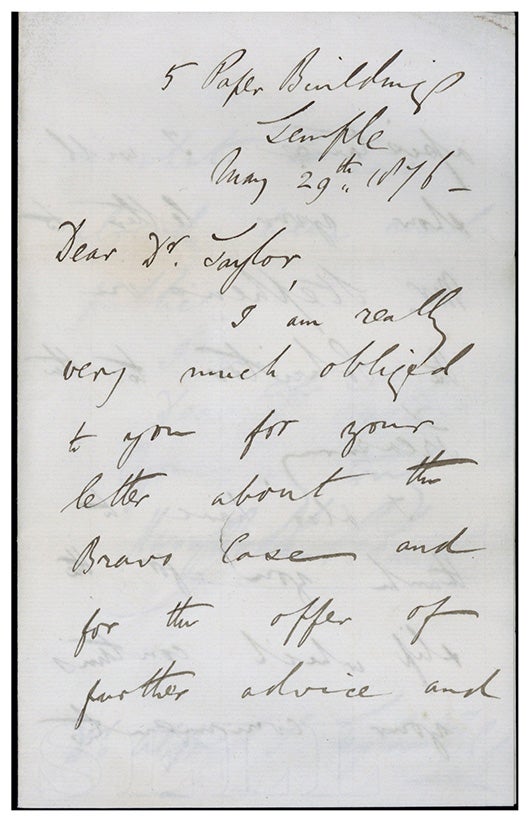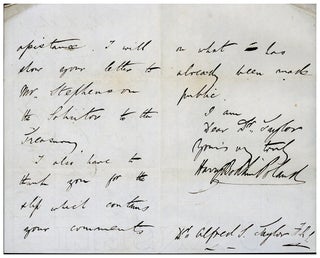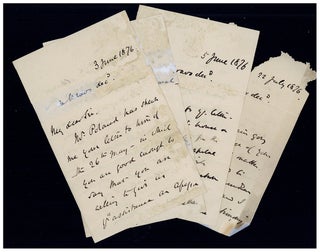Correspondence and galley proof relating to the Balham poisoning case
Publisher Information: 1876.
Taylor, Alfred Swaine (1806-80). Archive of material relating to the famous Charles Bravo poisoning case, consisting of (1) Autograph letter signed to Taylor from Harry Bodkin Poland (1829-1928). Bifolium. 3pp. Temple [London], 29 May 1876. 205 x 127 mm. (2) 3 autograph letters signed to Taylor from Augustus K. Stephenson (1827-1904). 15pp. total. [London], 3 June 1876 (2 bifolia, 8pp.); 5 June 1876 (bifolium, 4pp.); and 22 July 1876 (bifolium, 3pp.). 184 x 114 mm. (3) [Taylor.] The Balham mystery. Galley proof, corrected in Taylor’s hand, of the first portion of an unsigned article in The British Medical Journal (20 May 1876): 631-633. 578 x 148 mm. Together 4 letters and one printed proof. Some rodent damage to Stephenson’s letters affecting several words, mended in several places with clear tape. Small lacuna along one fold in the galley proof affecting a few words. Minor dampstaining but good to very good.
From the library of Alfred Swaine Taylor, founder of forensic toxicology, an archive relating to the notorious and sensational Charles Bravo poisoning, a case that is still unsolved. The Bravo mystery has inspired several works of fiction, including Shirley Jackson’s We Have Always Lived in the Castle (1962) and a three-part BBC serial titled The Poisoning of Charles Bravo (1975).
Bravo (1845-76), a 33-year-old barrister, died of tartar emetic (antimony) poisoning on 21 April 1876, less than five months after his marriage to a wealthy widow; the marriage was reportedly an unhappy one. The inquest on Bravo’s death, held on 25 and 28 April, returned an open verdict, but the circumstances of the case were so suspicious that Taylor offered his expert advice to Harry Bodkin Poland, one of the attorneys for the Crown. Our archive includes the letter Poland sent thanking Taylor for “your letter about the Bravo Case and for the offer of further advice and assistance,” and informing Taylor that he “will show your letter to Mr. [Augustus K.] Stephenson the Solicitor to the Treasury.” Stephenson is represented in the archive by three letters asking for Taylor’s expert opinion on the case: “You have read the account of the Post-mortem encl. by Dr. Payne . . . That being so, does it enable you to form an opinion as to whether the antimony was taken in solid food . . . (letter of 3 June). “Assuming small traces of antimony to have been found in the liver of a deceased person—Can you form any opinion as to length of time before death that the antimony was taken?” (letter of 5 June). “Can you tell me whether antimony in the form of tartar emetic wd. if taken in small doses at intervals during pregnancy induce a miscarriage? (letter of 22 July).
The last item in our archive is a galley proof, corrected in Taylor’s hand, of the first two-thirds of an article on the Bravo case published on 20 May in the British Medical Journal; although the article is unsigned, it was most likely written by Taylor. Based on the medical evidence, Taylor concluded that Bravo had ingested the fatal dose of antimony during his last meal. He severely criticized the investigators in the case for not testing the remains of the bottle of wine he had drunk with the meal—“the only article of food not shared in common with the three who sat at the dinner-table . . . If tartar emetic had been found in this wine much of the present mystery hanging about the case would be removed . . . In tracing the further history of this bottle, we learn that no one now knows what became of it or its contents.”
Book Id: 48462Price: $950.00




